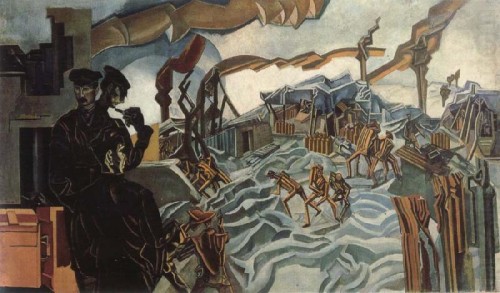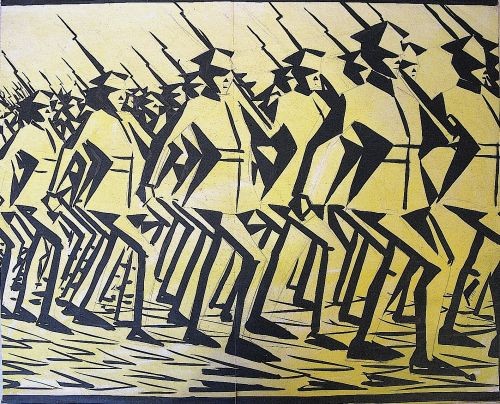lundi, 21 janvier 2013
Classical Modernism & the Art of the Radical Right

Classical Modernism & the Art of the Radical Right
By Jonathan Bowden
Edited by Alex Kurtagić
Editor’s Note:
The following is an excerpt from Jonathan Bowden’s Heat. He wrote the text aged 30, between July and September 1992. The text is reproduced as it appears, only lightly edited for spelling and punctuation.
. . . this brings a particular dilemma to the surface, namely the division between political and literary extremism. This is the division or discrepancy, if one exists, between the expectation, thought, and expression of a particular desire and its political realization. Indeed, Stephen Spender was quick to point out in his introduction to Alistair Hamilton’s book The Appeal of Fascism: Fascism and the Intellectuals [2]![]() , that a large amount of guilt underlay the Leftist response to fascism in the thirties—namely, his own flirtation with communism, among others, could be explained by the proximity he saw between intellectual gestures and the irrationalism of the radical Right.
, that a large amount of guilt underlay the Leftist response to fascism in the thirties—namely, his own flirtation with communism, among others, could be explained by the proximity he saw between intellectual gestures and the irrationalism of the radical Right.
In a sense Spender had recognized that an enormous amount of anti-bourgeois emotion and Romantic conceit—the entire sweep of Romanticism, Symbolism, and the Decadence—had at root “fascistic” emotions. This was a somewhat sweeping statement, it had to be admitted, but it was not completely inaccurate. For as with the Symbolist and decadent liberal anarchist Octave Mirbeau and his Garden of Supplicants, a large amount of Romantic rhetoric was bourgeois anti-bourgeois. In other words, it was so radical it soon began to take leave of the class, namely the middle class, which had given it birth. It was Spender’s understanding (in a rudimentary way) of the thesis which George Lukács would later put in a more forceful manner (namely, in The Destruction of Reason) that turned this poet into a pansy-Bolshevik; a pink shade of red—a member of the Homintern. Yet Spender grasped a fundamental point, which is often overlooked, and this has to do with the educated antecedents of classical fascism. It is as if—at least at one level of consciousness—all work of a Romantic, pre-modern, anti-modern, illiberal, and anti-Victorian guise presaged a classical vision of the Right. It even penetrated into the early stages of modernism—where an attempt was made to clear away the “decadent” effluvium of High Romanticism with some sharp-edged early modernism, if not neo-classicism in modern guise. Hence, the fact that Lewis, Pound, Eliot, and Hulme were “soured” Romantics; cynical post-Romantics, if you will. Men who viewed Romanticism with a certain leavened sardonicism. It was a bitter and twisted form of modernism which looked to the past as it demolished it and to the future as it remonstrated with it on behalf of forms of the past. As a result, classical early modernism had two conflict strands within it. One of these went forward into an analysis of pure form—the architecture of formal misstatement—where all that matters is the consideration of a particular type of form; a formalist criteria, a logarithmic exercise in relation to the possibility of taste—whereby modern art produced through Surrealism and its aborted pre-birth/after-birth (Dadaism) to a consideration of color, tactility, and the instrumental nature of a form of vision. When there was nothing left to say—when art had been neutered by the nature of the photographic image, on the one hand, and the impossibility of expressing meaningful statement in a “bourgeois world,” on the other. (The latter in accordance with a particular type of minimalist Marxist aesthetic; the sort of thing which was an Adornoesque parody of itself.) While another tendency in modernism has yet to be explored and this is the proto-classicism which led early modernists to experiment with the possibility of a return to classical simplicity by virtue of a modernist aesthetic. This was why a large number of early modernists, like Epstein and Gaudier-Brzeska (whose work outraged traditionalists), were so interested in the purity of classical form—its aesthetic simplicity and proportion. Likewise, modern classicists, of a highly modernist and individualist character, like Maurras and T. E. Hulme, preached a new form of art which was spare, linear, rectangular, and masculine. In some respects, this predisposition teetered on the edge of two conflicting cultural vistas. On the one hand, it wished to go back even to before Romanticism, on the other, it wanted to recreate everything again in a way which had never been done before.

As can be seen from the projected career of various modernists, the modern aesthetic could only go so far, in that a large number would fall away before the vista of total modernity. This is in relation to a pitiful summation of complete modernism which entered into a form of reiterated stylization; sheer form in the pursuit of its absence, the formlessness of an aesthetic concerned with nothing but the possibility of misstatement. Hence, the fact that Lewis, Dalí, Marinetti, de Chirico, Roberts, Gaudier-Brzeska, and many more, gradually fell away from modernism—Dalí towards a symbolic, classical, neo-Romantic form of iconography, namely religious painting, and Lewis towards modernist figuration, expressive linearity, anti-abstraction, and blindness. Also, the latter was to repudiate a form of aesthetic futility, the abandoned purpose of nihilistic modernism—i.e., the sheer purposelessness of empty abstraction; the pursuit of a type of form which had nothing to communicate—in his book that was also a form of recantation, namely The Demon of Progress in the Arts [4]![]() .
.
So we can say that there was a form of arrested classicism within early modernism which later came to reject it. This type of art either put modernism at the service of a neo-classical state, i.e., futurism in Fascist Italy, or it embraced fully-fledged traditional neo-classicism à la Arno Breker and the return to a naturalist form of neo-Grecian art. This was a type of counter-revolution in relation to modernism; a reformatory form of counter-reformation—a type of European modernity that was anti-modernist, a modern form of non-formalist criteria, neither academic nor anti-academic. It was a form of anti-formalist, anti-Bolshevik revolutionary tradition in relation to artistic procedure. What became known—somewhat crassly—as “Nazi art.”
Indeed, it is interesting to note that after the war, after defeat, these various strands came together again, if only in the form of friendship between the various protagonists—namely, the practitioners of a form of pre-to-early modernism that had a classical bias and straightforward neo-classicists who were the radical and talented vanguard of a type of artistic traditionalism; revolutionary artistic traditionalism nonetheless. The people concerned were Breker, Dalí, Fuchs, Pound, Cocteau, Hauptmann, Céline, members of the Wagner family, Speer (if only retrospectively), and the gradual reconsideration of Vorticism and Futurism—as the political passions which had led to opposition against them began to fall away.
Source: http://www.wermodandwermod.com/newsitems/news110120131209.html [5]
Article printed from Counter-Currents Publishing: http://www.counter-currents.com
URL to article: http://www.counter-currents.com/2013/01/classical-modernism-and-the-art-of-the-radical-right/
00:04 Publié dans art | Lien permanent | Commentaires (0) | Tags : art, angleterre, wyndham lewis, peinture, avant-gardes |  |
|  del.icio.us |
del.icio.us |  |
|  Digg |
Digg | ![]() Facebook
Facebook



Les commentaires sont fermés.